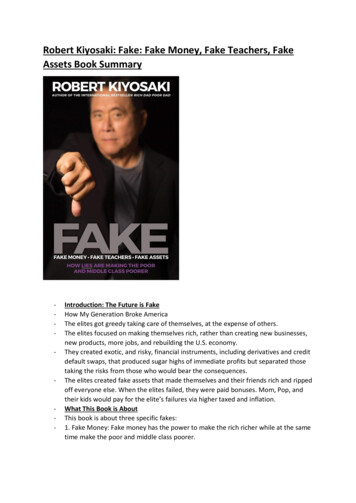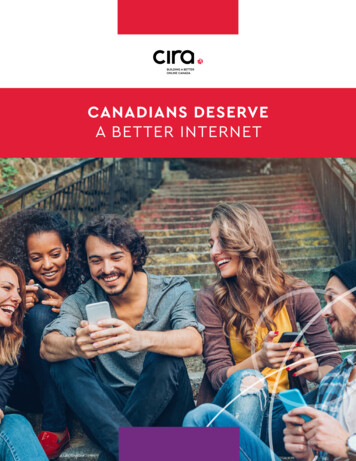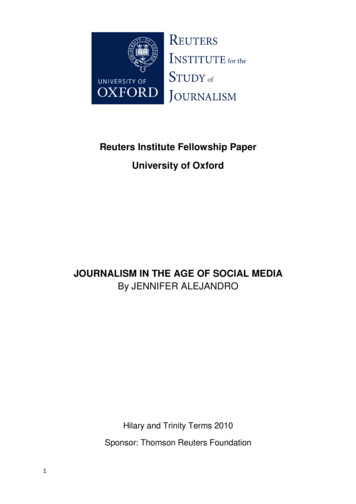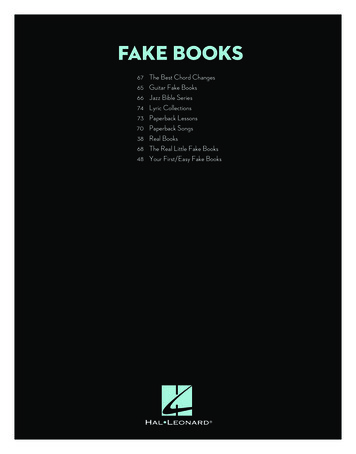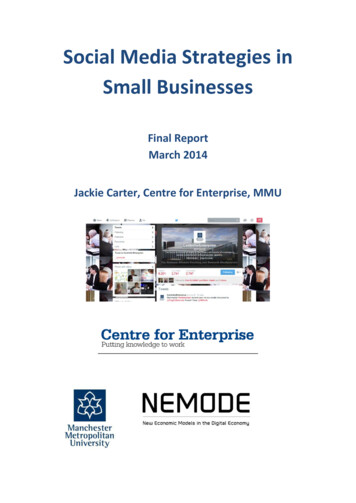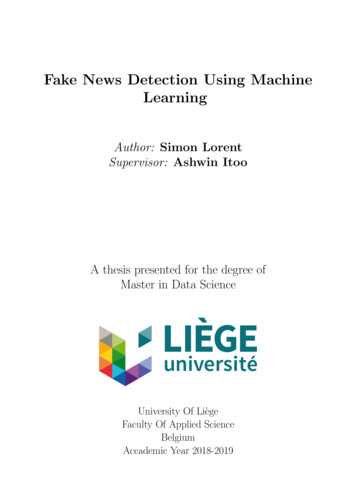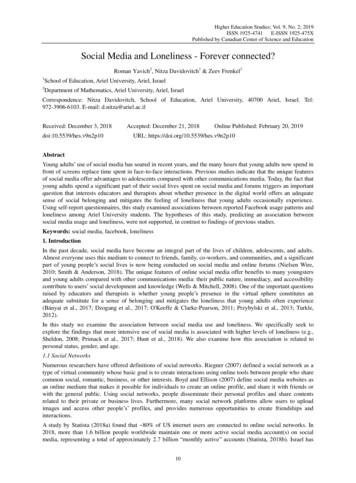
Transcription
Journal of Economic Perspectives—Volume 31, Number 2—Spring 2017—Pages 211–236Social Media and Fake News in the 2016ElectionHunt Allcott and Matthew GentzkowAmerican democracy has been repeatedly buffeted by changes in media technology. In the 19th century, cheap newsprint and improved presses allowedpartisan newspapers to expand their reach dramatically. Many have arguedthat the effectiveness of the press as a check on power was significantly compromised as a result (for example, Kaplan 2002). In the 20th century, as radio and thentelevision became dominant, observers worried that these new platforms wouldreduce substantive policy debates to sound bites, privilege charismatic or “telegenic”candidates over those who might have more ability to lead but are less polished, andconcentrate power in the hands of a few large corporations (Lang and Lang 2002;Bagdikian 1983). In the early 2000s, the growth of online news prompted a new setof concerns, among them that excess diversity of viewpoints would make it easierfor like-minded citizens to form “echo chambers” or “filter bubbles” where theywould be insulated from contrary perspectives (Sunstein 2001a, b, 2007; Pariser2011). Most recently, the focus of concern has shifted to social media. Social mediaplatforms such as Facebook have a dramatically different structure than previousmedia technologies. Content can be relayed among users with no significant thirdparty filtering, fact-checking, or editorial judgment. An individual user with notrack record or reputation can in some cases reach as many readers as Fox News,CNN, or the New York Times. Hunt Allcott is Associate Professor of Economics, New York University, New York City,New York. Matthew Gentzkow is Professor of Economics, Stanford University, Stanford,California. Both authors are Research Associates, National Bureau of Economic Research,Cambridge, Massachusetts.†For supplementary materials such as appendices, datasets, and author disclosure statements, see thearticle page athttps://doi.org/10.1257/jep.31.2.211doi 10.1257/jep.31.2.211
212Journal of Economic PerspectivesFollowing the 2016 election, a specific concern has been the effect of falsestories—“fake news,” as it has been dubbed—circulated on social media. Recentevidence shows that: 1) 62 percent of US adults get news on social media (Gottfriedand Shearer 2016); 2) the most popular fake news stories were more widely sharedon Facebook than the most popular mainstream news stories (Silverman 2016);3) many people who see fake news stories report that they believe them (Silvermanand Singer-Vine 2016); and 4) the most discussed fake news stories tended to favorDonald Trump over Hillary Clinton (Silverman 2016). Putting these facts together,a number of commentators have suggested that Donald Trump would not havebeen elected president were it not for the influence of fake news (for examples, seeParkinson 2016; Read 2016; Dewey 2016).Our goal in this paper is to offer theoretical and empirical background toframe this debate. We begin by discussing the economics of fake news. We sketcha model of media markets in which firms gather and sell signals of a true state ofthe world to consumers who benefit from inferring that state. We conceptualizefake news as distorted signals uncorrelated with the truth. Fake news arises in equilibrium because it is cheaper to provide than precise signals, because consumerscannot costlessly infer accuracy, and because consumers may enjoy partisan news.Fake news may generate utility for some consumers, but it also imposes private andsocial costs by making it more difficult for consumers to infer the true state of theworld—for example, by making it more difficult for voters to infer which electoralcandidate they prefer.We then present new data on the consumption of fake news prior to the election. We draw on web browsing data, a new 1,200-person post-election online survey,and a database of 156 election-related news stories that were categorized as false byleading fact-checking websites in the three months before the election.First, we discuss the importance of social media relative to sources of politicalnews and information. Referrals from social media accounted for a small share oftraffic on mainstream news sites, but a much larger share for fake news sites. Trust ininformation accessed through social media is lower than trust in traditional outlets.In our survey, only 14 percent of American adults viewed social media as their “mostimportant” source of election news.Second, we confirm that fake news was both widely shared and heavily tiltedin favor of Donald Trump. Our database contains 115 pro-Trump fake stories thatwere shared on Facebook a total of 30 million times, and 41 pro-Clinton fake storiesshared a total of 7.6 million times.Third, we provide several benchmarks of the rate at which voters were exposedto fake news. The upper end of previously reported statistics for the ratio of pagevisits to shares of stories on social media would suggest that the 38 million sharesof fake news in our database translates into 760 million instances of a user clickingthrough and reading a fake news story, or about three stories read per Americanadult. A list of fake news websites, on which just over half of articles appear to be false,received 159 million visits during the month of the election, or 0.64 per US adult. Inour post-election survey, about 15 percent of respondents recalled seeing each of 14
Hunt Allcott and Matthew Gentzkow213major pre-election fake news headlines, but about 14 percent also recalled seeing aset of placebo fake news headlines—untrue headlines that we invented and that neveractually circulated. Using the difference between fake news headlines and placeboheadlines as a measure of true recall and projecting this to the universe of fake newsarticles in our database, we estimate that the average adult saw and remembered 1.14fake stories. Taken together, these estimates suggest that the average US adult mighthave seen perhaps one or several news stories in the months before the election.Fourth, we study inference about true versus false news headlines in our surveydata. Education, age, and total media consumption are strongly associated withmore accurate beliefs about whether headlines are true or false. Democrats andRepublicans are both about 15 percent more likely to believe ideologically alignedheadlines, and this ideologically aligned inference is substantially stronger forpeople with ideologically segregated social media networks.We conclude by discussing the possible impacts of fake news on voting patternsin the 2016 election and potential steps that could be taken to reduce any negativeimpacts of fake news. Although the term “fake news” has been popularized onlyrecently, this and other related topics have been extensively covered by academicliteratures in economics, psychology, political science, and computer science. SeeFlynn, Nyhan, and Reifler (2017) for a recent overview of political misperceptions.In addition to the articles we cite below, there are large literatures on how new information affects political beliefs (for example, Berinsky 2017; DiFonzo and Bordia2007; Taber and Lodge 2006; Nyhan, Reifler, and Ubel 2013; Nyhan, Reifler, Richey,and Freed 2014), how rumors propagate (for example, Friggeri, Adamic, Eckles,and Cheng 2014), effects of media exposure (for example, Bartels 1993, DellaVignaand Kaplan 2007, Enikolopov, Petrova, and Zhuravskaya 2011, Gerber and Green2000, Gerber, Gimpel, Green, and Shaw 2011, Huber and Arceneaux 2007,Martin and Yurukoglu 2014, and Spenkuch and Toniatti 2016; and for overviews,DellaVigna and Gentzkow 2010, and Napoli 2014), and ideological segregation innews consumption (for example, Bakshy, Messing, and Adamic 2015; Gentzkow andShapiro 2011; Flaxman, Goel, and Rao 2016).Background: The Market for Fake NewsDefinition and HistoryWe define “fake news” to be news articles that are intentionally and verifiablyfalse, and could mislead readers. We focus on fake news articles that have politicalimplications, with special attention to the 2016 US presidential elections. Our definition includes intentionally fabricated news articles, such as a widely shared articlefrom the now-defunct website denverguardian.com with the headline, “FBI agentsuspected in Hillary email leaks found dead in apparent murder-suicide.” It alsoincludes many articles that originate on satirical websites but could be misunderstood as factual, especially when viewed in isolation on Twitter or Facebook feeds.For example, in July 2016, the now-defunct website wtoe5news.com reported that
214Journal of Economic PerspectivesPope Francis had endorsed Donald Trump’s presidential candidacy. The WTOE 5News “About” page disclosed that it is “a fantasy news website. Most articles on wtoe5news.com are satire or pure fantasy,” but this disclaimer was not included in thearticle. The story was shared more than one million times on Facebook, and somepeople in our survey described below reported believing the headline.Our definition rules out several close cousins of fake news: 1) unintentionalreporting mistakes, such as a recent incorrect report that Donald Trump hadremoved a bust of Martin Luther King Jr. from the Oval Office in the White House;2) rumors that do not originate from a particular news article; 1 3) conspiracy theories (these are, by definition, difficult to verify as true or false, and they are typicallyoriginated by people who believe them to be true); 2 4) satire that is unlikely to bemisconstrued as factual; 5) false statements by politicians; and 6) reports that areslanted or misleading but not outright false (in the language of Gentzkow, Shapiro,and Stone 2016, fake news is “distortion,” not “filtering”).Fake news and its cousins are not new. One historical example is the “GreatMoon Hoax” of 1835, in which the New York Sun published a series of articles aboutthe discovery of life on the moon. A more recent example is the 2006 “FlemishSecession Hoax,” in which a Belgian public television station reported that theFlemish parliament had declared independence from Belgium, a report that alarge number of viewers misunderstood as true. Supermarket tabloids such as theNational Enquirer and the Weekly World News have long trafficked in a mix of partiallytrue and outright false stories.Figure 1 lists 12 conspiracy theories with political implications that have circulated over the past half-century. Using polling data compiled by the AmericanEnterprise Institute (2013), this figure plots the share of people who believed eachstatement is true, from polls conducted in the listed year. For example, substantialminorities of Americans believed at various times that Franklin Roosevelt had priorknowledge of the Pearl Harbor bombing, that Lyndon Johnson was involved in theKennedy assassination, that the US government actively participated in the 9/11bombings, and that Barack Obama was born in another country.The long history of fake news notwithstanding, there are several reasons tothink that fake news is of growing importance. First, barriers to entry in the mediaindustry have dropped precipitously, both because it is now easy to set up websitesand because it is easy to monetize web content through advertising platforms.Because reputational concerns discourage mass media outlets from knowinglyreporting false stories, higher entry barriers limit false reporting. Second, as wediscuss below, social media are well-suited for fake news dissemination, and social1Sunstein (2007) defines rumors as “claims of fact—about people, groups, events, and institutions—thathave not been shown to be true, but that move from one person to another, and hence have credibilitynot because direct evidence is available to support them, but because other people seem to believethem.”2Keeley (1999) defines a conspiracy theory as “a proposed explanation of some historical event (or events)in terms of the significant causal agency of a relatively small group of persons—the conspirators––actingin secret.”
Social Media and Fake News in the 2016 Election215Figure 1Share of Americans Believing Historical Partisan Conspiracy Theories1975: The assassination of Martin Luther Kingwas the act of part of a large conspiracy1991: President Franklin Roosevelt knew Japaneseplans to bomb Pearl Harbor but did nothing1994: The Nazi extermination of millionsof Jews did not take place1995: FBI deliberately set the Waco firein which the Branch Davidians died1995: US government bombed the government buildingin Oklahoma City to blame extremist groups1995: Vincent Foster, the former aide toPresident Bill Clinton, was murdered1999: The crash of TWA Flight 800 over Long Islandwas an accidental strike by a US Navy missile2003: Lyndon Johnson was involved in theassassination of John Kennedy in 19632003: Bush administration purposely misled the publicabout evidence that Iraq had banned weapons2007: US government knew the 9/11 attacks werecoming but consciously let them proceed2007: US government actively planned orassisted some aspects of the 9/11 attacks2010: Barack Obama was born in another country0102030405060Share of people who believe it is true (%)Note: From polling data compiled by the American Enterprise Institute (2013), we selected allconspiracy theories with political implications. This figure plots the share of people who reportbelieving the statement listed, using opinion polls from the date listed.media use has risen sharply: in 2016, active Facebook users per month reached 1.8billion and Twitter’s approached 400 million. Third, as shown in Figure 2A, Galluppolls reveal a continuing decline of “trust and confidence” in the mass media “whenit comes to reporting the news fully, accurately, and fairly.” This decline is moremarked among Republicans than Democrats, and there is a particularly sharpdrop among Republicans in 2016. The declining trust in mainstream media couldbe both a cause and a consequence of fake news gaining more traction. Fourth,Figure 2B shows one measure of the rise of political polarization: the increasinglynegative feelings each side of the political spectrum holds toward the other. 3 As we3The extent to which polarization of voters has increased, along with the extent to which it has beendriven by shifts in attitudes on the right or the left or both, are widely debated topics. See Abramowitzand Saunders (2008), Fiorina and Abrams (2008), Prior (2013), and Lelkes (2016) for reviews.
216Journal of Economic PerspectivesFigure 2Trends Related to Fake NewsA: Trust in Mainstream Media80Percent Great deal/Fair 0620102014B: Feeling Thermometer toward Other Political PartyFeeling thermometer(0 least positive, 100 most)50Republicans’ feeling thermometertoward Democratic Party4030Democrats’ feeling thermometertoward Republican Party20198019841988199219962000200420082012Note: Panel A shows the percent of Americans who say that they have “a great deal” or “a fairamount” of “trust and confidence” in the mass media “when it comes to reporting the news fully,accurately, and fairly,” using Gallup poll data reported in Swift (2016). Panel B shows the average“feeling thermometer” (with 100 meaning “very warm or favorable feeling” and 0 meaning “verycold or unfavorable feeling”) of Republicans toward the Democratic Party and of Democratstoward the Republican Party, using data from the American National Election Studies (2012).
Hunt Allcott and Matthew Gentzkow217discuss below, this could affect how likely each side is to believe negative fake newsstories about the other.Who Produces Fake News?Fake news articles originate on several types of websites. For example, somesites are established entirely to print intentionally fabricated and misleadingarticles, such as the above example of denverguardian.com. The names of thesesites are often chosen to resemble those of legitimate news organizations. Othersatirical sites contain articles that might be interpreted as factual when seen outof context, such as the above example of wtoe5news.com. Still other sites, such asendingthefed.com, print a mix between factual articles, often with a partisan slant,along with some false articles. Websites supplying fake news tend to be short-lived,and many that were important in the run-up to the 2016 election no longer exist.Anecdotal reports that have emerged following the 2016 election providea partial picture of the providers behind these sites. Separate investigations byBuzzFeed and the Guardian revealed that more than 100 sites posting fake newswere run by teenagers in the small town of Veles, Macedonia (Subramanian 2017).Endingthefed.com, a site that was responsible for four of the ten most popularfake news stories on Facebook, was run by a 24-year-old Romanian man (Townsend2016). A US company called Disinfomedia owns many fake news sites, includingNationalReport.net, USAToday.com.co, and WashingtonPost.com.co, and its ownerclaims to employ between 20 and 25 writers (Sydell 2016). Another US-basedproducer, Paul Horner, ran a successful fake news site called National Report foryears prior to the election (Dewey 2014). Among his most-circulated stories wasa 2013 report that President Obama used his own money to keep open a Muslimmuseum during the federal government shutdown. During the election, Hornerproduced a large number of mainly pro-Trump stories (Dewey 2016).There appear to be two main motivations for providing fake news. The firstis pecuniary: news articles that go viral on social media can draw significant advertising revenue when users click to the original site. This appears to have been themain motivation for most of the producers whose identities have been revealed. Theteenagers in Veles, for example, produced stories favoring both Trump and Clintonthat earned them tens of thousands of dollars (Subramanian 2017). Paul Hornerproduced pro-Trump stories for profit, despite claiming to be personally opposed toTrump (Dewey 2016). The second motivation is ideological. Some fake news providersseek to advance candidates they favor. The Romanian man who ran endingthefed.com, for example, claims that he started the site mainly to help Donald Trump’scampaign (Townsend 2016). Other providers of right-wing fake news actually saythey identify as left-wing and wanted to embarrass those on the right by showing thatthey would credulously circulate false stories (Dewey 2016; Sydell 2016).A Model of Fake NewsHow is fake news different from biased or slanted media more broadly? Isit an innocuous form of entertainment, like fictional films or novels? Or does it
218Journal of Economic Perspectiveshave larger social costs? To answer these questions, we sketch a model of supplyand demand for news loosely based on a model developed formally in Gentzkow,Shapiro, and Stone (2016).There are two possible unobserved states of the world, which could representwhether a left- or right-leaning candidate will perform better in office. Media firmsreceive signals that are informative about the true state, and they may differ in theprecision of these signals. We can also imagine that firms can make costly investments to increase the accuracy of these signals. Each firm has a reporting strategythat maps from the signals it receives to the news reports that it publishes. Firmscan either decide to report signals truthfully, or alternatively to add bias to reports.Consumers are endowed with heterogeneous priors about the state of the world.Liberal consumers’ priors hold that the left-leaning candidate will perform better inoffice, while conservative consumers’ priors hold that the right-leaning candidatewill perform better. Consumers receive utility through two channels. First, they wantto know the truth. In our model, consumers must choose an action, which couldrepresent advocating or voting for a candidate, and they receive private benefits ifthey choose the candidate they would prefer if they were fully informed. Second,consumers may derive psychological utility from seeing reports that are consistentwith their priors. Consumers choose the firms from which they will consume newsin order to maximize their own expected utility. They then use the content of thenews reports they have consumed to form a posterior about the state of the world.Thus, consumers face a tradeoff: they have a private incentive to consume preciseand unbiased news, but they also receive psychological utility from confirmatorynews.After consumers choose their actions, they may receive additional feedbackabout the true state of the world—for example, as a candidate’s performance isobserved while in office. Consumers then update their beliefs about the quality ofmedia firms and choose which to consume in future periods. The profits of mediafirms increase in their number of consumers due to advertising revenue, and mediafirms have an incentive to build a reputation for delivering high levels of utilityto consumers. There are also positive social externalities if consumers choose thehigher-quality candidate.In this model, two distinct incentives may lead firms to distort their reports in thedirection of consumers’ priors. First, when feedback about the true state is limited,rational consumers will judge a firm to be higher quality when its reports are closerto the consumers’ priors (Gentzkow and Shapiro 2006). Second, consumers mayprefer reports that confirm their priors due to psychological utility ( Mullainathanand Shleifer 2005). Gentzkow, Shapiro, and Stone (2016) show how these incentives can lead to biased reporting in equilibrium, and apply variants of this model tounderstand outcomes in traditional “mainstream” media.How would we understand fake news in the context of such a model? Producersof fake news are firms with two distinguishing characteristics. First, they make noinvestment in accurate reporting, so their underlying signals are uncorrelated withthe true state. Second, they do not attempt to build a long-term reputation for
Social Media and Fake News in the 2016 Election219quality, but rather maximize the short-run profits from attracting clicks in an initialperiod. Capturing precisely how this competition plays out on social media wouldrequire extending the model to include multiple steps where consumers see “headlines” and then decide whether to “click” to learn more detail. But loosely speaking,we can imagine that such firms attract demand because consumers cannot distinguish them from higher-quality outlets, and also because their reports are tailoredto deliver psychological utility to consumers on either the left or right of the political spectrum.Adding fake news producers to a market has several potential social costs. First,consumers who mistake a fake outlet for a legitimate one have less-accurate beliefsand are worse off for that reason. Second, these less-accurate beliefs may reducepositive social externalities, undermining the ability of the democratic process toselect high-quality candidates. Third, consumers may also become more skepticalof legitimate news producers, to the extent that they become hard to distinguishfrom fake news producers. Fourth, these effects may be reinforced in equilibrium bysupply-side responses: a reduced demand for high-precision, low-bias reporting willreduce the incentives to invest in accurate reporting and truthfully report signals.These negative effects trade off against any welfare gain that arises from consumerswho enjoy reading fake news reports that are consistent with their priors.Real Data on Fake NewsFake News DatabaseWe gathered a database of fake news articles that circulated in the threemonths before the 2016 election, using lists from three independent third parties.First, we scraped all stories from the Donald Trump and Hillary Clinton tags onSnopes (snopes.com), which calls itself “the definitive Internet reference source forurban legends, folklore, myths, rumors, and misinformation.” Second, we scrapedall stories from the 2016 presidential election tag from PolitiFact (politifact.com),another major fact-checking site. Third, we use a list of 21 fake news articles thathad received significant engagement on Facebook, as compiled by the news outletBuzzFeed (Silverman 2016).4 Combining these three lists, we have a database of156 fake news articles. We then gathered the total number of times each article wasshared on Facebook as of early December 2016, using an online content databasecalled BuzzSumo (buzzsumo.com). We code each article’s content as either proClinton (including anti-Trump) or pro-Trump (including anti-Clinton).This list is a reasonable but probably not comprehensive sample of the majorfake news stories that circulated before the election. One measure of comprehensiveness is to look at the overlap between the lists of stories from Snopes, PolitiFact,and BuzzFeed. Snopes is our largest list, including 138 of our total of 156 articles. As4Of these 21 articles, 12 were fact-checked on Snopes. Nine were rated as “false,” and the other threewere rated “mixture,” “unproven,” and “mostly false.”
220Journal of Economic Perspectivesa benchmark, 12 of the 21 articles in the BuzzFeed list appear in Snopes, and 4 ofthe 13 articles in the PolitiFact appear in Snopes. The lack of perfect overlap showsthat none of these lists is complete and suggests that there may be other fake newsarticles that are omitted from our database.Post-Election SurveyDuring the week of November 28, 2016, we conducted an online survey of1208 US adults aged 18 and over using the SurveyMonkey platform. The samplewas drawn from SurveyMonkey’s Audience Panel, an opt-in panel recruited fromthe more than 30 million people who complete SurveyMonkey surveys every month(as described in more detail at https://www.surveymonkey.com/mp/audience/).The survey consisted of four sections. First, we acquired consent to participateand a commitment to provide thoughtful answers, which we hoped would improvedata quality. Those who did not agree were disqualified from the survey. Second,we asked a series of demographic questions, including political affiliation beforethe 2016 campaign, vote in the 2016 presidential election, education, and race/ethnicity. Third, we asked about 2016 election news consumption, including timespent on reading, watching, or listening to election news in general and on socialmedia in particular, and the most important source of news and information aboutthe 2016 election. Fourth, we showed each respondent 15 news headlines about the2016 election. For each headline, we asked, “Do you recall seeing this reported ordiscussed prior to the election?” and “At the time of the election, would your bestguess have been that this statement was true?” We also received age and incomecategories, gender, and census division from profiling questions that respondentshad completed when they first started taking surveys on the Audience panel. Thesurvey instrument can be accessed at https://www.surveymonkey.com/r/RSYD75P.Each respondent’s 15 news headlines were randomly selected from a list of30 news headlines, six from each of five categories. Within each category, our listcontains an equal split of pro-Clinton and pro-Trump headlines, so 15 of the 30 articles favored Clinton, and the other 15 favored Trump. The first category containssix fake news stories mentioned in three mainstream media articles (one in the NewYork Times, one in the Wall Street Journal, and one in BuzzFeed) discussing fake newsduring the week of November 14, 2016. The second category contains the fourmost recent pre-election headlines from each of Snopes and PolitiFact deemed tobe unambiguously false. We refer to these two categories individually as “Big Fake”and “Small Fake,” respectively, or collectively as “Fake.” The third category containsthe most recent six major election stories from the Guardian’s election timeline.We refer to these as “Big True” stories. The fourth category contains the two mostrecent pre-election headlines from each of Snopes and PolitiFact deemed to beunambiguously true. We refer to these as “Small True” stories. Our headlines inthese four categories appeared on or before November 7.The fifth and final category contains invented “Placebo” fake news headlines,which parallel placebo conspiracy theories employed in surveys by Oliver and Wood(2014) and Chapman University (2016). As we explain below, we include these
Hunt Allcott and Matthew Gentzkow221Placebo headlines to help control for false recall in survey responses. We inventedthree damaging fake headlines that could apply to either Clinton or Trump, thenrandomized whether a survey respondent saw the pro-Clinton or pro-Trumpversion. We experimented with several alternative placebo headlines during a pilotsurvey, and we chose these three because the data showed them to be approximately equally believable as the “Small Fake” stories. (We confirmed using Googlesearches that none of the Placebo stories had appeared in actual fake news articles.) Online Appendix Table 1, available with this article at this journal’s website(http://e-jep.org), lists the exact text of the headlines presented in the survey. Theonline Appendix also presents a model of survey responses that makes precise theconditions under which differencing with respect to the placebo articles leads tovalid inference.Yeager et al. (2011) and others have shown that opt-in internet panels suchas ours typically do not provide nationally representative results, even afterreweighting. Notwithstanding, reweighting on observable variables such as education and internet usage can help to address the sample selection biases inherent inan opt-in internet-based sampling frame. For all results reported below, we reweightthe online sample to match the nationwide adult population on ten characteristics that we hypothes
set of placebo fake news headlines—untrue headlines that we invented and that never actually circulated. Using the difference between fake news headlines and placebo headlines as a measure of true recall and projecting this to the universe of fake news articles in our database, we estimate that the average adult saw and remembered 1.14
